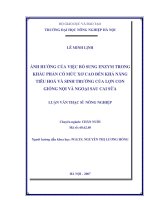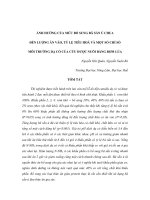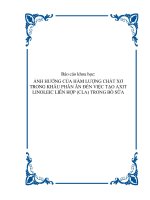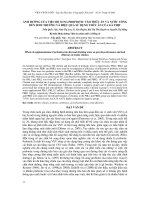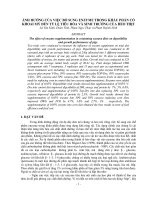Báo cáo nông nghiệp:" Ảnh hưởng của mức bổ sung thóc vào khẩu phần cơ sở là rau muống (Ipomoea aquatica) hay rau lang (Ipomoea batatas) đến hiệu quả sử dụng thức ăn và sinh trưởng của thỏ trắng New Zealand" pps
Bạn đang xem bản rút gọn của tài liệu. Xem và tải ngay bản đầy đủ của tài liệu tại đây (461.38 KB, 7 trang )
J. Sci. Dev. 2011, 9 (Eng.Iss. 1): 21 - 27 HANOI UNIVERSITY OF AGRICULTURE
EFFECTS OF GRADED LEVELS OF PADDY RICE SUPPLEMENTED TO WATER SPINACH
(
Ipomoea aquatica
) OR SWEET POTATO (
Ipomoea batatas
) VINES AS BASAL
DIETS ON FEED UTILIZATION AND GROWTH OF NEW ZEALAND WHITE RABBITS
Ảnh hưởng của mức bổ sung thóc vào khẩu phần cơ sở là rau muống (Ipomoea
aquatica) hay rau lang (Ipomoea batatas) đến hiệu quả sử dụng thức ăn
và sinh trưởng của thỏ trắng New Zealand
Nguyen Thi Duong Huyen
1
, Nguyen Hung Son
2
, Nguyen Van Dat
3
, Nguyen Xuan Trach
1
1
Hanoi University of Agriculture
2
National Institute of Animal Sciences
3
Vinh Phuc College of Economics and Technology
Correspoding author email:
Received date: 14.02.2011 Accepted date: 10.04.2011
TÓM TẮT
Một thí nghiệm được tiến hành nhằm đánh giá ảnh hưởng của mức bổ sung thóc vào khẩu phần
cơ sở là rau muống (Ipomoea aquatica) hay rau lang (
Ipomoea batatas) đến hiệu quả sử dụng thức ăn
và sinh trưởng của thỏ trắng New Zealand. Tổng số 40 thỏ thịt sinh trưởng được chia thành 2 nhóm
chính để cho ăn một trong hai loại rau. Mỗi nhóm chính này được chia thành 5 lô, mỗi lô 4 con, để
được bổ sung một trong năm mức thóc tương ứng với 0, 1, 2, 3, 4% thể trọng của thỏ. Thí nghiệm
cho thấy rằng mức bổ sung thóc có ảnh hưởng rất rõ rệt đến lượng thu nhận rau khi tính theo khối
lượng tuyệt đối (kg/con/ngày) cũng như tính theo phần trăm thể trọng thỏ, nhưng không ảnh hưởng
đáng kể (P>0.05) đến tổng lượng thức ăn thu nhận của thỏ. Bổ sung thóc làm tỷ lệ tiêu hoá nhưng lại
làm tăng hiệu quả chuyển hoá thức ăn và tăng tốc độ sinh trưởng của thỏ (P<0.001). So với rau lang
thì rau muống được thỏ ăn ít hơn nhưng có tỷ lệ chuyển hoá thành tăng trọng tốt hơn, trong khi cả
hai loại rau đều có tỷ lệ tiêu hoá tương tự nhau. Do việc bổ sung thóc vào khẩu phần cơ sở là các loại
rau giàu đạm có những ảnh hưởng trái ngược nhau lên tỷ lệ tiêu hoá thức ăn và sinh trưởng của thỏ
nên cần có những nghiên cứu tiếp theo để làm sáng tỏ cơ chế tác động.
Từ khoá: Bổ sung, rau lang, rau muống, thỏ, thóc.
SUMMARY
An experiment was conducted to determine effects of graded levels of paddy rice supplemented
to water spinach (Ipomoea aquatica) or sweet potato (
Ipomoea batatas) vines as basal diets feed
utilization and growth of growing New Zealand White rabbits. A total of 40 male growing rabbits were
equally divided into 2 main groups of 20 each to be fed on either of the two basal diets. Each of the
two main groups were divided into 5 sub-groups (treatments) of 4 rabbits each to receive one of 5
graded levels of paddy rice, which were 0, 1, 2, 3, 4% of live weight (LW). It was found that the level of
paddy rice supplementation had a highly significant (P<0.001) effect on the intake of forage either in
an absolute term (g/head/day) or as percentage of LW, but without affecting total feed intake (P>0.05).
Paddy rice supplementation reduced digestibility (P<0.01) but improved feed conversion (P<0.001),
and increased LW gain (P<0.001). Compared to sweet potato vines, water spinach was less consumed
but better converted to weight gain with similar digestibility. Due to the opposing effects of paddy rice
supplementation to protein-rich vegetables as basal diets on digestibility of feed and growth of
rabbits, further investigations are warranted to find the underlying mechanisms.
Key words: Paddy rice, rabbits, supplementation, sweet potato, water spinach.
21
Effects of graded levels of paddy rice supplemented to water spinach (Ipomoea aquatica)
1. INTRODUCTION
Rabbits can efficiently utilize fibrous feed by
courtesy of their feeding and digestive strategies.
Among other forages, water spinach (Ipomoea
aquatica) and sweet potato (Ipomoea batatas) vines
are protein-rich vegetables (Ly Thi Luyen, 2003;
Hong, 2003), which have been commonly used as a
valuable basal diet for rabbits (Nguyen Thi Kim
Dong et al., 2006a,b), Pok Samkol et al., 2006a,b,c)
and Doan Thi Giang et al., 2006). To improve the
nutritional balance in diets based on such protein-
rich vegetables, different supplements rich in
digestible carbohydrates or fiber, or both, have
been carried out (Hongthong Phimmmasan et al.,
2004; Khuc Thi Hue and Preston, 2006; Doan Thi
Giang et al., 2006; Nguyen Huu Tam et al., 2008);
However, results obtained from those studies have
been questionable. Paddy rice seems to be an
appropriate supplement to protein-rich vegetables
fed as the basal diet for fast growing rabbits owing
to its high energy and fiber contents. The present
study was aimed to test responses of fast growing
rabbits in terms of feed intake, digestibility and
growth rate to graded levels of paddy rice
supplemented to water spinach or sweet potato
vines fed as a basal diet.
2. MATERIALS AND METHODS
A 5 x 2 factorial experiment was conducted to
determine effects of 5 graded levels of paddy rice
(0, 1, 2, 3, and 4% of live weight) supplemented to
water spinach (Ipomoea aquatica) or sweet potato
(Ipomoea batatas) vines fed as 2 basal diets for
growing New Zealand White rabbits on feed intake,
digestibility, average daily gain (ADG), and feed
conversion ratio (FCR). A total of 40 male growing
rabbits at 8 weeks of age were randomly divided
into 2 main groups of 20 each to be fed on either of
the two basal diets. Each of the two main groups
was divided into 5 sub-groups (treatments) of 4
rabbits each to receive one of the 5 graded levels of
paddy rice.
The experiment lasted for 10 weeks following
7 days of adaptation at the experimental farm of the
Faculty of Animal Science and Aquaculture, Hanoi
University of Agriculture, Hanoi, Vietnam, during
the period from late March to end of May 2010.
Before the experiment began the rabbits were
vaccinated against hemorrhagic diarrhea and
drenched against intestinal parasites. During the
experiment, rabbits were housed and fed in
individual cages. The animals were fed either water
spinach or sweet potato vines ad libitum three times
a day at 8:00, 14:00, and 20:00h. Paddy rice was
fed once per day at 11:00am. Drinking water was
made available at all times.
All animals were individually weighed at the
beginning and thereafter once a week until the end
of the experiment to calculate the average daily
gain (ADG) as the slope of the linear regression of
live weight on time. Total feed and feces
collections were made over 7 consecutive days in
the middle of the experiment. The feeds offered and
refusals were collected and weighed daily in the
morning. Representative samples of feces (10%)
were collected daily from the total feces collected
and stored at -25°C. At the end of the 7 days, the
samples were bulked according to individual
animals. Feed samples were taken over the same
period.
Feed and feces samples were analyzed for DM
according to AOAC (1990). Daily feed intake was
calculated as g DM/head/day and as percentage of
live weight. Feed conversion ratio (FCR) was
calculated as a ratio of DM intake/live weight gain.
Apparent total tract DM digestibility was computed
as DM digestibility (%) = (A-B/A)*100, where A
and B are total DM intake and total DM in feces,
respectively.
Data were subjected to analyses of variance
(ANOVA) for a 5x2 factorial model with
interactions, using the General Linear Model
(GLM) of Minitab 16 (2010). Pair-wise
comparisons of means were done using the Tukey
method. Regression analyses were made using
Microsoft Excel (2007).
3. RESULTS AND DISCUSSION
Table 1 shows relationships between levels of
paddy rice supplementation and feed intake in
rabbits fed a basal diet of sweet potato vines or
water spinach vines. The level of paddy rice
supplementation had a highly significant effect on
intake of the basal diet (P<0.001) but not on the
total feed intake either in an absolute term
(g/head/day) or as percentage of live weight
(P>0.05). Significant differences in the observed
parameters were also found between water spinach
and sweet potato vines as basal diets (P<0.001). No
interactions between level of paddy rice
supplementation and type of forage (basal diet)
were found significant (P>0.05).
22
Nguyen Thi Duong Huyen, Nguyen Hung Son, Nguyen Van Dat, Nguyen Xuan Trach
Table 1. Feed intake as affected by level of paddy rice supplementation and type of forage
Intake of basal diet (DM) Total feed intake (DM)
g/head/day % LW g/head/day % LW
Level of paddy rice supplementation (% LW)
0 94.93
a
5.36
a
94.93
a
5.36
a
1 79.49
b
4.47
b
99.90
a
5.61
a
2 52.14
c
2.93
c
98.59
a
5.53
a
3 32.64
d
1.81
d
96.31
a
5.33
a
4 31.75
d
1.70
d
104.51
a
5.60
a
SEM 3.08 0.18 3.47
a
0.21
P <0.001 <0.001 >0.05 >0.05
Type of forage
Sweet potato vines 64.46
a
3.62
a
105.50
a
5.88
a
Water spinach vines 51.92
b
2.89
b
92.19
b
5.10
b
SEM 1.95 0.11 2.19 0.13
P <0.001 <0.001 <0.001 <0.001
N.B.: Means that do not share a letter are significantly different at P<0.05.
Figure 1. Relationship between level of paddy
rice supplementation and feed intake in rabbits
fed a basal diet of sweet potato vines
Figure 2. Relationship between level of paddy rice
supplementation and feed intake in rabbits fed a
basal diet of water spinach vines
Figure 3. Effect of actual paddy rice intake on
forage intake and total feed intake in rabbits fed
a basal diet of sweet potato vines
Figure 4. Effect of actual paddy rice intake on
forage intake and total feed intake in rabbits fed a
basal diet of water spinach vines
23
Effects of graded levels of paddy rice supplemented to water spinach (Ipomoea aquatica)
As can be seen in Figures 1 and 2, the more
paddy rice was supplemented, the more it was
consumed; however, at the same time, intake of the
basal diet was reduced accordingly. The responses
followed nonlinear curves with high determination
coefficients (R²). As a result, the total feed intake
remained almost unaffected (Figures 3 and 4).
Figures 3 and 4 also show strong relationships
between actual paddy rice intake, as a result of
level of supplementation, on intake of the basal diet
of sweet potato vines (R² = 0.971) or water spinach
vines (R² = 0.981). However, paddy rice intake
explained not much variation in total feed intake
whether the basal diet was sweet potato vines (R² =
0.296) or water spinach vines (R² = 0.076). That
was because there was a substitution rate (the
slope) of -0.864 for sweet potato vines and -0.949
for water spinach vines when paddy rice was
supplemented. That is, paddy rice replaced forage
in the feed intake.
Concerning effects of paddy rice
supplementation on growth of rabbits, Table 2 and
Table 3 show relationships between the average
daily gain (ADG) of rabbits and level of paddy rice
supplementation and type of forage (sweet potato
vines vs. water spinach vines) in the basal diet. The
effect of level of paddy rice on ADG was found
highly significant (P<0.001), but no significant
difference in ADG was found between water
spinach and sweet potato vines as basal diets
(P>0.05). And, there was no significant interaction
between level of paddy rice and type of forage for
ADG (P>0.05). The higher the amount of paddy
rice was supplemented, the more it was consumed
and, as a result, the higher the ADG was.
The results in tables 2 and 3 show that the more
paddy rice was offered, the more it was consumed
with lesser intake of forage, and, as a result, the
proportion of paddy rice in the diet increased
accordingly. Figure 5 and Figure 6 show strong
positive relationships between the proportion of
paddy rice in the diet and live weight gain of
rabbits. This positive effect of paddy rice on growth
may be explained by means of energy
concentration of the diet. However, a previous
study by Hongthong Phimmmasan et al. (2004),
supplementation with highly digestible
carbohydrate (high energy density) in the form of
broken rice was not successful. So, the positive
effect found in the present study might be due to
the fibrous husk of paddy, as in other experiments
(Khuc Thi Hue and Preston, 2006; Doan Thi Giang
et al., 2006), supplements rich in fibre gave positive
results with rabbits fed diets based on water
spinach. It might also be due to combined effects of
both fibre (from the husk) and starch of paddy rice
supplemented to diets based on protein-rich
vegetables. The results of this study confirmed the
results from the experiment by Nguyen Huu Tam et
al. (2008) that rabbits fed on water spinach had
higher feed intake and live weight gain when they
were supplemented with paddy rice.
From tables 2 and 3, it can also be seen that
the rabbits had higher ADGs for the first 5 weeks
compared to those calculated for the whole 10
weeks of experiment. It was definitely due to the
unfavorable changes in the weather conditions. It
was getting hotter and wetter, and, as a result, the
ADG was becoming lower and lower toward the
end of the experiment. It might be too hot for the
exotic rabbits during the last weeks of the
experiment.
To find the mechanism behind the positive
effect of paddy rice supplementation on live weight
gain of rabbits fed a basal diet of protein-rich
vegetables, improvement in digestibility might have
been expected. However, relationships between
proportion of paddy rice in the diet and DM
digestibility in rabbits fed a basal diet of sweet
potato or water spinach vines in the present study,
as reflected in Table 4 as well as in Figures 7 and 8,
show the opposing effect. The more paddy rice was
consumed, and the higher proportion of it in the
diet as a result, the lower the digestibility was;
whereas feed utilization (FCR) tended to be better.
This should be questions for further investigation.
Where was the effect inserted? Was it because of
low digestibility of the husk, which lowered
digestibility of the total diet? Is there something in
the husk or somewhere in paddy rice, not in broken
rice, that can improve post-digestive metabolism in
favor of live weight gain? Or was it due to other
reasons?
It should be also noted that type of forage
(water spinach vs. sweet potato vines) had no
significant effect on digestibility of the total diet
DM (P>0.05). However, water spinach had a better
(lower) FCR compared to sweet potato vines
(P<0.05). No interactions between level of paddy
rice supplementation and type of forage (basal diet)
on digestibility and FCR were found significant
(P>0.05).
24
Nguyen Thi Duong Huyen, Nguyen Hung Son, Nguyen Van Dat, Nguyen Xuan Trach
Table 2. Average daily gain (ADG) of rabbits as affected by level of paddy rice supplementation
and type of forage in the basal diet
Average daily gain (g/head/day)
First 5 weeks Total 10 weeks
Level of paddy rice supplementation (% LW)
0 21.79
b
14.15
c
1 22.24
b
15.35
bc
2 25.61
ab
17.26
ab
3 27.31
a
17.94
a
4 28.58
a
18.37
a
SEM 1.07 0.56
P <0.001 <0.001
Type of forage
Sweet potato vines 25.39
a
16.60
a
Water spinach vines 24.82
a
16.54
a
SEM 0.68 0.36
P >0.05 >0.05
N.B.: Means that do not share a letter are significantly different.
Table 3. Average daily gain (ADG) of rabbits fed a basal diet of sweet potato vines
or water spinach vines with different levels of paddy rice supplementation
Average daily gain (g/head/day)
Basal diet
Level of rice supplementation
(% LW)
First 5 weeks Total 10 weeks
0 22.89
ab
13.47
d
1 22.29
ab
14.46
cd
2 26.05
ab
17.76
abc
3 26.80
ab
18.40
ab
Sweet potato vines
4 28.94
b
19.36
a
0 20.70
a
14.82
bcd
1 22.19
ab
16.25
abcd
2 25.17
ab
16.77
abcd
3 27.82
ab
17.48
abc
Water spinach
4 28.22
b
17.39
abc
SEM
1.51 0.79
P (Interaction)
>0.05 >0.05
N.B.: Means that do not share a letter are significantly different.
Figure 5. Relationship between proportion of
paddy rice in the diet and live weight gain in
rabbits fed a basal diet of sweet potato vines
Figure 6. Relationship between proportion of
paddy rice in the diet and live weight gain in
rabbits fed a basal diet of water spinach vines
25
Effects of graded levels of paddy rice supplemented to water spinach (Ipomoea aquatica)
Table 4. Apparent dry matter (DM) digestibility (%) and feed conversion ratio (FCR)
as affected by level of paddy rice supplementation and type of forage
Apparent DM digestibility (%) FCR
Level of paddy rice supplementation (% LW)
0 81.66
a
4.41
ab
1 80.22
ab
4.51
a
2 76.95
abc
3.85
abc
3 75.02
c
3.55
c
4 75.83
bc
3.73
bc
SEM 1.24 0.19
P <0.01 <0.01
Type of forage
Sweet potato vines 77.32
a
4.24
a
Water spinach 78.55
a
3.78
b
SEM 0.79 0.12
P >0.05 <0.05
N.B.: Means that do not share a letter are significantly different.
Figure 7. Relationship between proportion of
paddy rice in the diet and DM digestibility in
rabbits fed a basal diet of sweet potato vines
Figure 8. Relationship between proportion of paddy
rice in the diet and DM digestibility in rabbits fed a
basal diet of water spinach vines
4. CONCLUSIONS
The more paddy rice was supplemented, the
less was the intake of the protein-rich vegetables in
the basal diet (P<0.001) without affecting total feed
intake (P>0.05) by the rabbit. Paddy rice
supplementation reduced digestibility of feed
(P<0.01) but increased live weight gain of rabbits
(P<0.001). Due to the opposing effects of paddy
rice supplementation to protein-rich vegetables as
basal diets on digestibility of feed and growth of
rabbits, further investigations are warranted to find
the underlying mechanisms.
Acknowledgements
The authors are very grateful to the Swedish
International Development Cooperation Agency,
Department for Research Cooperation (Sida-SAREC),
through the regional MEKARN Project, for the
financial support of this study. Dr. T.R. Preston is
highly appreciated for his important advices on the
experimental design and data analysis.
REFERENCES
AOAC (1990) Official Methods of Analysis of the
AOAC International.
26
Nguyen Thi Duong Huyen, Nguyen Hung Son, Nguyen Van Dat, Nguyen Xuan Trach
on growth of rabbits of supplementing a basal
diet of water spinach (Ipomoea aquatica) with
vegetable wastes and paddy rice.
Livestock
Research for Rural Development. Volume 21,
Article # 174.
Retrieved, from http://www. lrrd.
org/lrrd21/10/hang21174.htm
.
Doan Thi Giang, Khuc Thi Hue, Dinh Van Binh
and Nguyen Thi Mui (2006). Effect of Guinea
grass on feed intake, digestibility and growth
performance of rabbits fed a molasses block and
either water spinach (Ipomoea aquatica) or sweet
potato (Ipomoea batatas L) vines. Workshop-
seminar "Forages for Pigs and Rabbits"
MEKARN-CelAgrid, Phnom Penh, Cambodia,
22-24 August, 2006. Article #23 Retrieved June
8, 108, from
/ proprf /
gang
.htm.
Nguyen Thi Kim Dong, Nguyen Van Thu and T. R.
Preston (2006a). Effect of dietary protein supply
on the reproductive performance of crossbred
rabbits. Proceedings of the MEKARN workshop
on forages for pigs and rabbits, Phnom Penh,
Cambodia, 22-24 August 2006.
Hong T. T. T. (2003). Evaluation of Sweet potato
leaves as a protein source for growing pigs in
Central Vietnam. MSc Thesis in the programme
"Tropical Livestock Systems". SLU, Dept. of
Animal Nutrition and Management, P.O.Box
7024, Uppsala, Sweden.
Nguyen Thi Kim Dong, Nguyen Van Thu, R B
Ogle and T. R. Preston (2006b). Effect of
supplementation level of water spinach
(Ipomoea aquatica) leaves in diets based on Para
grass (Brachiaria mutica) on intake, nutrient
utilization, growth rate and economic returns of
crossbred rabbits in the Mekong Delta of
Vietnam. Proceedings of the MEKARN
workshop on forages for pigs and rabbits,
Phnom Penh, Cambodia, 22-24 August 2006.
Hongthong Phimmmasan, Siton Kongvongxay,
Chhay Ty and T. R. Preston (2004). Water
spinach (Ipomoea aquatica) and Stylo 184
(Stylosanthes guianensis CIAT 184) as basal
diets for growing rabbits.
Livestock Research for
Rural Development.
Volume 16, Article # 34.
Retrieved from.
hong16034.htm
.
Pok Samkol, T. R. Preston and J. Ly (2006a)
Digestibility indices and N balance in growing
rabbits fed a basal diet of water spinach
(Ipomoea aquatica) supplemented with broken
rice.
Livestock Research for Rural Development.
Volume 18, Article # 22.
Retrieved June 8, 108,
from
http://www. lrrd.org / lrrd18 /02 / samk
18022.htm
.
Khuc Thi Hue and T. R. Preston (2006). Effect of
different sources of supplementary fibre on
growth of rabbits fed a basal diet of fresh water
spinach (
Ipomoea aquatica). Livestock Research
for Rural Development. Volume 18, Article #58.
Retrieved June 8, 2008, from http://www. lrrd.
org/ lrrd18/4/hue18058.htm
Pok Samkol, T. R. Preston and J. Ly (2006b).
Effect of increasing offer level of water spinach
(Ipomoea aquatica) on intake, growth and
digestibility coefficients of rabbits. Livestock
Research for Rural Development. Volume 18,
Article #25. Retrieved March 7, 2006, from
/>Ly Thi Luyen (2003). Effect of the urea level on
biomass production of water spinach (Ipomoea
aquatica) grown in soil and in water; Retrieved,
from MEKARN Mini-projects.
http://www.
mekarn.org/msc2003-05/ miniprojects/ webpage/
luyen.htm
.
Pok Samkol, T. R. Preston and R. A. Leng (2006c).
Effect of offering leaves or stems of water
spinach on patterns of eating, consumption of
caecotropes and excretion of feces by growing
rabbits. Proceedings of the MEKARN workshop
on forages for pigs and rabbits, Phnom Penh,
Cambodia, 22-24 August 2006.
Microsoft Excel (2007). Microsoft Corporation.
USA.
Minitab 16 (2010). Statistical Software. Minitab,
Inc., USA.
Nguyen Huu Tam, Vo Thanh Tuan, Vo Lam, Bui
Phan Thu Hang and T. R. Preston (2008). Effects
27
